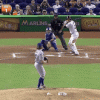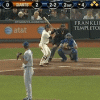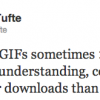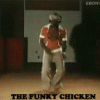I’ve got a friend who is a high school athletic trainer. As she was looking for examples I thought of this post from Austin Kleon. I’ve used the gif in my classroom for journal topics, but haven’t done much past that. Has anybody used them in a science class or physics?Taking the animated .gif seriously
I was delighted when @EdwardTufte, the data visualization guru, posted on Twitter about the merits of animated GIFs over video when doing analytic work.
Jonah Weiner in his piece on the “glorious GIF renaissance,” wrote that while animated GIFs might seem like nostalgic, throwback, internet junk food, “they perform distinct functions that other formats can’t.”
One thing the GIF does well is “the money shot,” or “the payoff,” or the “Did you see that?” moment:
There is an appealing economy to these GIFs. They get to the point instantaneously, and at the exact moment when one feels the impulse to rewind and watch the climax again, the loop restarts right where it should. In the two minutes it might take me to load a viral video and watch it in full, I can watch the money shots of 15 different viral videos. Yes, we’re talking about decadent levels of impatience, inanity, and time-wasting here, but GIFs allow us to waste less time online—or, rather, to waste it more efficiently.
Weiner also writes that GIFs are great at “reliving and exulting in shared experiences, where zero setup is needed because a familiarity with context is assumed on the part of viewers.”
Tufte pointed to this batch of amazing baseball pitches as a perfect use of the medium. (A baseball pitch also contains the two elements above that Weiner wrote about: “the money shot” and a “familiarity with context.”) It got me thinking about ways in which we could use animated GIFs as not just time-wasters, but as explanations or illuminations… (UPDATE: @adamgoucher sent me this fantastic post of animated GIFs showing the physics of World Series baseball swings.)
I was also reminded of this batch of James Brown dance moves where the .gif-maker sampled pieces of a youtube video, added annotations (“funky chicken,” and “The Boogaloo”), and put them into a photoset, providing a fabulous entertainment, yes, but also suddenly giving us a “Small multiples” information display that Tufte is so fond of:
“Small multiples resemble the frames of a movie: a series of graphics, showing the same combination of variables, indexed by changes in another variable.” (pg. 170, The Visual Display of Qualitative Information)
Tufte has said over and over: “To make comparisons, it’s better to have information adjacent in space than stacked in time.” You can stretch this a bit and fit it to the internet, and certainly the Tumblr dashboard. (Witness this animated GIF of a Clayton Cubitt video getting almost 3x as many likes as the original.) Seems like for maximum effect, it’s often better to have information in space period.
UPDATE: my friend @bonitasarita sent me this PBS Off Book video: Animated GIFs: The Birth of a Medium:
GIFs are one of the oldest image formats used on the web. Throughout their history, they have served a huge variety of purposes, from functional to entertainment. Now, 25 years after the first GIF was created, they are experiencing an explosion of interest and innovation that is pushing them into the terrain of art. In this episode of Off Book, we chart their history, explore the hotbed of GIF creativity on Tumblr, and talk to two teams of GIF artists who are evolving the form into powerful new visual experiences.




